
Gobiidae is a family of bony fish in the order Gobiiformes, one of the largest fish families comprising more than 2,000 species in more than 200 genera, sometimes referred to as the "true gobies". Most of them are relatively small, typically less than 10 cm (3.9 in) in length. The Gobiidae includes some of the smallest vertebrates in the world, such as Trimmatom nanus and Pandaka pygmaea, Trimmatom nanus are under 1 cm long when fully grown, then Pandaka pygmaea standard length are 9mm (0.35 in),maximum known standard length are 11 mm (0.43 in). Some large gobies can reach over 30 cm (0.98 ft) in length, but that is exceptional. Generally, they are benthic, or bottom-dwellers. Although few are important as food for humans, they are of great significance as prey species for commercially important fish such as cod, haddock, sea bass, and flatfish. Several gobiids are also of interest as aquarium fish, such as the dartfish of the genus Ptereleotris. Phylogenetic relationships of gobiids have been studied using molecular data.

The tiger pistol shrimp belongs to the family of snapping shrimp.
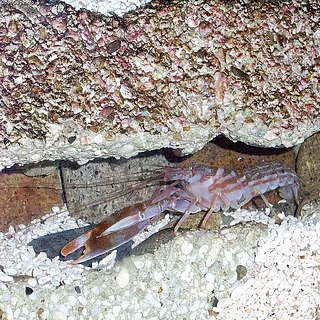
Alpheidae is a family of caridean snapping shrimp, characterized by having asymmetrical claws, the larger of which is typically capable of producing a loud snapping sound. Other common names for animals in the group are pistol shrimp or alpheid shrimp.
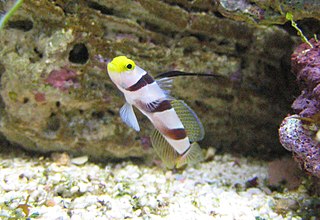
Stonogobiops nematodes, the Filament-finned prawn-goby, the Antenna goby, the high-fin goby, the red-banded goby, the high-fin red-banded goby, the striped goby, the barber-pole goby, or the black-ray Goby, is a species of marine goby native to the Indian Ocean and western Pacific Ocean from the Seychelles to the Philippines and Bali.

Amblyeleotris is a genus of fish in the family Gobiidae found throughout the Indo-Pacific region. This is the largest genus of the shrimp gobies or prawn gobies, so-called because of their symbiotic relationship with certain alpheid shrimps. The shrimp excavates and maintains a burrow used by both animals while the goby, which has far superior eyesight, acts as a lookout for predators. The shrimp maintains almost constant contact with the fish with an antenna. These species vary considerably in size from less than 30 mm to almost 200 mm standard length.

Amblyeleotris rubrimarginata is a species of goby found on reefs or in sea grass beds in the western Pacific from New Caledonia to the Great Barrier Reef and around New Guinea, Indonesia, Malaysia and the Philippines. It can be found at depths of from 3 to 26 metres. As with other Amblyeleotris species, it has a symbiotic relationship with alpheid shrimps, one or a pair of gobies sharing a burrow with a pair of shrimps.
Amblyeleotris harrisorum is a species of goby currently only recorded from reefs around the island of Kiritimati in the Line Islands, Republic of Kiribati, in the central Pacific at a depth of around 32 metres (105 ft). As with other Amblyeleotris species, it has a symbiotic relationship with alpheid shrimps.
Amblyeleotris marquesas is a species of goby only recorded from reefs around Nuku Hiva in the Marquesas Islands, French Polynesia in the central Pacific Ocean at depths of 20 to 25 metres. As with other species of their genus, this species has a symbiotic relationship with alpheid shrimps, in this case Alpheus randalli, one or a pair of gobies sharing a burrow with one or a pair of shrimps.

Amblyeleotris steinitzi, Steinitz' prawn goby or simply Steinitz' goby, is a species of small fish in the family Gobiidae. It lives in association with an alpheid shrimp and is found from the Red Sea through the Indian Ocean to the western Pacific Ocean.

The Gobiiformes are an order of fish that includes the gobies and their relatives. The order, which was previously considered a suborder of Perciformes, is made up of about 2,211 species that are divided between seven families. Phylogenetic relationships of the Gobiiformes have been elucidated using molecular data. Gobiiforms are primarily small species that live in marine water, but roughly 10% of these species inhabit fresh water. This order is composed chiefly of benthic or burrowing species; like many other benthic fishes, most gobiiforms do not have a gas bladder or any other means of controlling their buoyancy in water, so they must spend most of their time on or near the bottom. Gobiiformes means "Goby-like".

Ptereleotris hanae, the blue gudgeon dartfish, blue hana goby, is a species of dartfish native to the western Pacific Ocean. It is a reef inhabitant, being found at depths of from 3 to 50 metres, though usually no shallower than 6 metres (20 ft). It inhabits burrows made by alpheid shrimp, but unlike the Amblyeleotris gobies who normally associate with these shrimp, this species has no interactions with their shrimp hosts. This species can reach a length of 12 centimetres (4.7 in) TL. It can also be found in the aquarium trade.
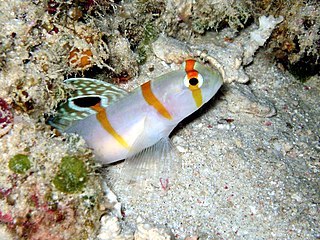
Amblyeleotris randalli, Randall's prawn goby, is a marine benthic species of goby native to tropical reefs of the central Indo-Pacific. This species can also be found in the aquarium trade.

Amblyeleotris wheeleri, the Gorgeous prawn-goby, is a species of goby native to tropical reefs of the Indian Ocean to the western Pacific Ocean. It can be found at depths of from 5 to 40 metres though is usually does not occur deeper than 15 metres (49 ft). It is a commensal with alpheid shrimps, most often being found in association with Alpheus ochrostriatus. This species can reach a length of 10 centimetres (3.9 in) SL. It can also be found in the aquarium trade. The specific name honours the English ichthyologist Alwynne Cooper Wheeler (1929-2005), who was curator of Fishes at the British Museum, "for his help over the years, particularly with the authors’ study of prawn-associated gobies of the Seychelles".

Amblyeleotris diagonalis, the Diagonal shrimpgoby, is a species of goby native to the Indian Ocean and the western Pacific Ocean where it can be found on reefs at depths of from 6 to 40 metres. It is commensal with alpheid shrimps. This species can reach a length of 11 centimetres (4.3 in) SL.

Amblyeleotris aurora, the pinkbar goby, is a species of goby native to reefs of the western Indian Ocean at depths of from 5 to 40 metres though usually not deeper than 10 metres (33 ft). It is commensal with the shrimp Alpheus randalli. This species can reach a length of 11 centimetres (4.3 in) TL. It can also be found in the aquarium trade.

Alpheus heterochaelis, the bigclaw snapping shrimp, is a snapper or pistol shrimp in the family Alpheidae. It is found in the western Atlantic Ocean and the Gulf of Mexico.
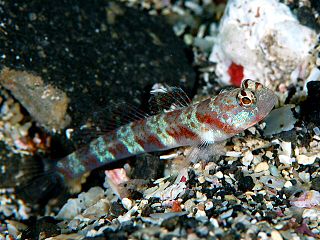
Amblyeleotris periophthalma, the broad-banded shrimp goby or the periophthalma shrimp goby, is a marine benthic species of goby native to reef environments of the Indo-West Pacific, Red Sea included.
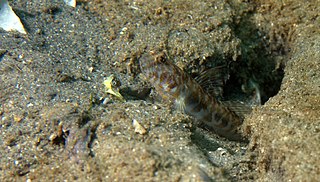
The orangespotted goby is a species of goby native to the tropical Atlantic coast from Bermuda and southern Florida through the Caribbean Sea and Gulf of Mexico south to the Caribbean coasts of Venezuela and Colombia, where it prefers silty bottoms around reefs. It is a commensal with an alpheid shrimp. This species grows to a length of 10 centimetres (3.9 in) TL. This species is the only known member of its genus.
Alpheus tricolor is a crustacean belonging to the family of snapping shrimp. It was first isolated in Indonesia and Sri Lanka. It counts with a setose carapace, an acute rostrum, shallow adrostral furrows and a basicerite with a strong ventrolateral tooth. The lamella of its scaphocerite is not reduced, with an anterior margin that is concave. Its third maxilliped counts with an epipodial plate bearing thick setae, while its first chelipeds are found with their merus bearing a strong disto-mesial tooth; its third pereiopod has an armed ischium, with a simple and conical dactylus. Its telson is broad, distally tapering, with 2 pairs of dorsal spines. The species is named after its characteristic colour pattern, including white, red and orange.

Alpheus fasqueli is a crustacean belonging to the family of snapping shrimp. It was first isolated in Sri Lanka. It counts with a setose carapace, an acute and carinate rostrum, and unarmed orbital hoods. Its basicerite has a strong ventrolateral tooth. The lamella of its scaphocerite is not reduced. Its third maxilliped counts with an epipodial plate bearing thick setae, while its first chelipeds are found with their merus bearing a strong disto-mesial tooth; its third pereiopod has an armed ischium, with a simple and conical dactylus. Its telson is broad, distally tapering, with 2 pairs of dorsal spines. The species is named after Frédéric Fasquel, a photographer who contributed rare shrimp specimens for the Muséum national d'histoire naturelle.
















